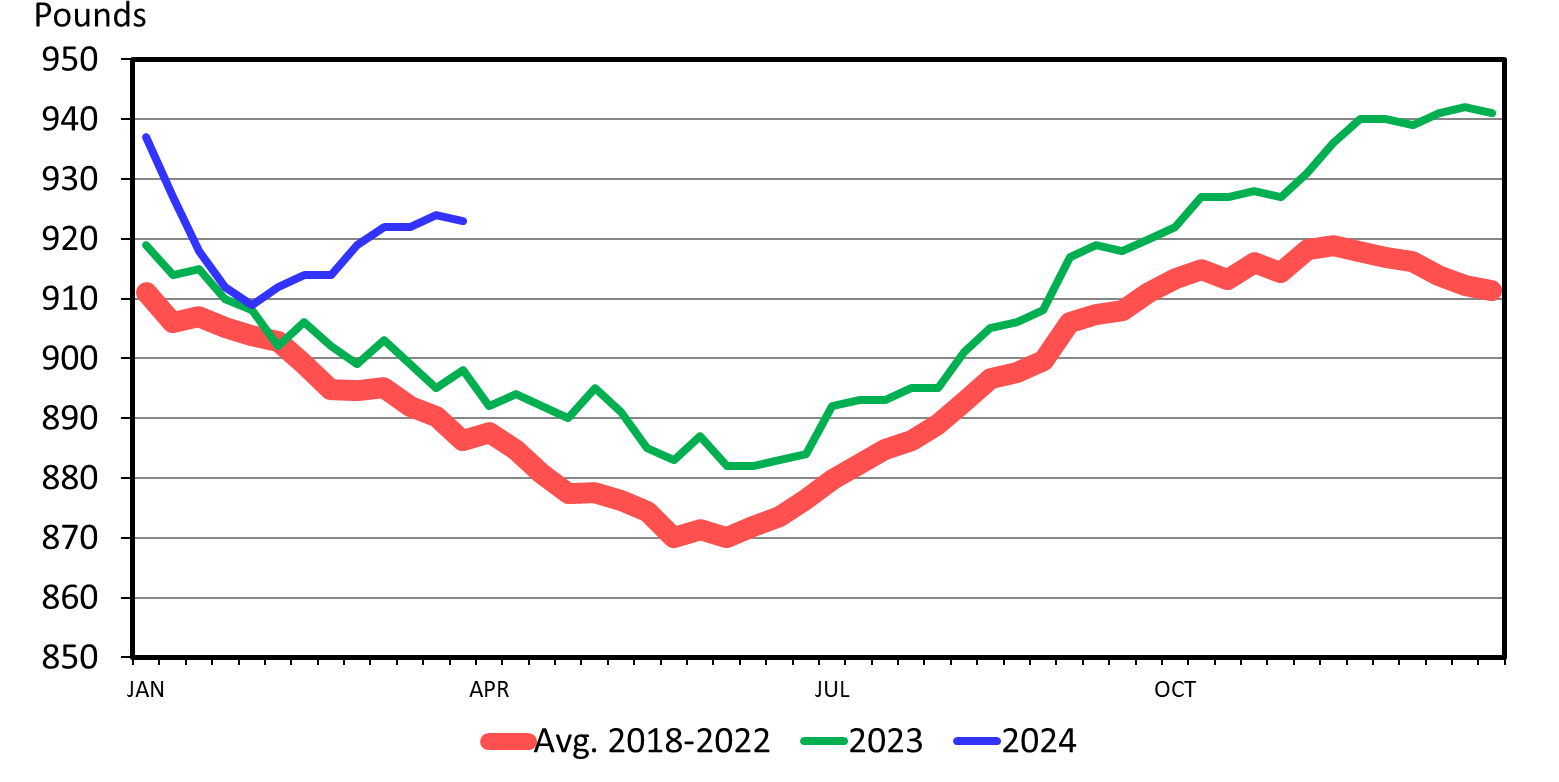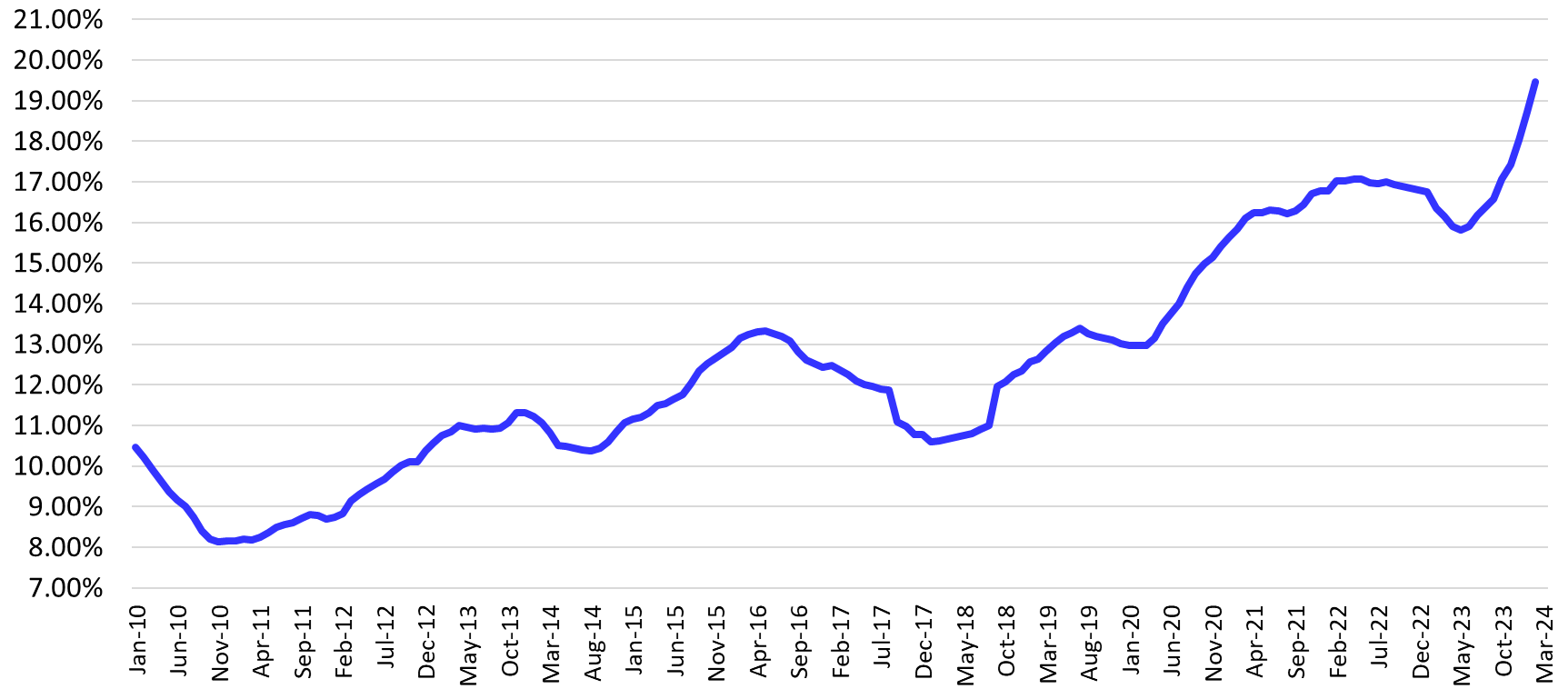Cow-Calf Corner | April 15, 2024
Carcass Weights, Quality Grade and Yield Grade
Derrell S. Peel, Oklahoma State University Extension Livestock Marketing Specialist
Fed steer carcass weights decreased from 937 to 909 pounds the first five weeks of 2024, the result of winter weather in December and January. Since the beginning of February, steer carcass weights increased counter-seasonally to 924 pounds before declining by one pound in the most recent weekly data (Figure 1). The current steer carcass weight is 25 pounds heavier than one year earlier. Carcass weights may decrease seasonally in the next few weeks but are expected to remain higher year over year for the remainder of the year. Heifer carcasses show a similar pattern and are currently 19 pounds heavier than one year ago.
Figure 1. Steer Dressed Weight Federally Inspected, Weekly.
Fed carcass weights are impacted both by long term trends and current market conditions. Carcass weights have trended heavier for over 60 years with steer carcass weights increasing by an average of 4.0 pounds per year, up over 240 pounds from 660 pounds in the 1960s to over 900 pounds in recent years. Heifer carcass weights have increased by an average of 4.5 pounds per year over the same period.
Carcass weights are further boosted at the current time by decreasing cattle numbers, which increases incentives to feed cattle longer as they try to maintain feedlot inventories. Decreasing corn prices adds additional incentive to feed cattle longer. Kansas feedlot data shows that steers are currently averaging 190 days on feed, up 9 days from one year ago and about 40 days longer than a decade ago. Increasing carcass weights are the result of more days on feed combined with changing cattle genetics and use of feeding technology, such as implants, ionophores and beta agonists.
One of the outcomes attributable to longer feeding periods is an increase in quality grading. Figure 2 shows the general increase in the percentage of Prime and Choice cattle over the past 15 years, from about 68 percent in 2010 to current levels near 85 percent. The average Choice and higher percentage has been steady the past four years.
Figure 2. Percent Prime/Choice Grade of Fed Cattle Offered for Quality Grading, 12 Months MA.
However, longer feeding periods also result in a decrease in yield grading. Figure 3 shows that the percentage of yield grade 4 and 5 cattle has generally increased over the past 15 years, from less than nine percent to an average of nearly 20 percent currently. The average increase in yield grade 4 and 5 cattle has been especially pronounced in the last year. Thus far in 2024, the Y4/5 percentage has averaged 23.7 percent.
Figure 3. Percent Yield Grade 4/5 of Fed Cattle Offered for Yielding Grading, 12 Months MA.
Increased Prime/Choice percentage and increased Y4/5 percentage are 66 percent correlated, meaning that they tend to move together. However, the increase in Y4/5 percentage in the past year has not been associated with an increase in the Prime/Choice percentage of feedlot cattle. Feedlots will continue to have incentives to push cattle weights, aided and abetted by packers who are also seeking additional pounds of beef as cattle numbers continue to tighten. Steer and heifer carcass weights will likely average heavier in 2024.
Does Your Selection and Mating Program Create Profit Potential?
Mark Z. Johnson, Oklahoma State University Extension Beef Cattle Breeding Specialist
One of the most important decisions cattlemen and cattlewomen face today is how to engineer their selection and mating program to add value to their next calf crop. In 2024 we have more genetic information on which to base selection decisions than ever before. Pedigreed, registered seedstock animals are sold with a registration paper documenting their age, pedigree and estimates of their breeding value for over 20 traits. These estimates of breeding value, in the form of EPDs, serve as a roadmap for meeting breeding objectives, improving additive genetic merit and thereby, adding value to your next calf crop.
The mating decision of whether or not to crossbreed in commercial beef herds is effectively the decision of if you want to capitalize on the benefits of heterosis or hybrid vigor. Hybrid vigor is the advantage in performance of the crossbred over the average level of performance of the purebred parents. Hybrid vigor is the result of non-additive genetic merit (or gene combination value) that is created by crossbreeding.
Reproductive traits respond to crossbreeding with high levels of heterosis. Scientific literature indicates well designed, systematic crossbreeding programs lead to crossbred cows weaning as much as 25% more pounds of calves over their lifetime. This is largely due to hybrid vigor giving the crossbred cow an advantage in fertility, reproductive fitness, longevity and maternal performance.
Growth traits are moderately heritable and show moderate levels of heterosis in response to crossbreeding. Carcass traits are highly heritable and show very little heterosis in response to crossbreeding. Marbling, in particular, is primarily the result to additive genetic merit.
So what does this all mean? The intended marketing endpoint of your calf crop (at weaning, as yearlings or as fed cattle on a carcass value system) should have a profound impact on the bull selection and mating decisions you make. How you intend to use a bull (as a terminal sire or a maternal sire) should have a profound impact on your bull selection and mating decisions as well.
This topic will lead off the 2024 Cattlemen’s Conference Blueprint For The Future – Part 2 at OSU on Wednesday, May 22 - 23, 2024. An economic simulation based on current input expenses, the value of calves, yearlings and fed cattle and the impact of additive genetic merit and heterosis on the traits of value at these marketing endpoints will be presented in a panel discussion featuring key industry leaders in the first session on Wednesday, May 22.
The 2024 conference is designed to give cattlemen and cattlewomen the opportunity to network with their peers, attend informative sessions, and learn from industry experts. The beef industry is as complex, ever changing and dynamic as any industry in the world. The objective of this conference is to provide you with the tools and information to thrive in the cattle business. We are hopeful attendees will take advantage of what the conference has to offer and leave feeling inspired and empowered to prepare for the future and take their cattle operation to the next level. Register today and find more information on the Cattle Conference website.
Mark Johnson, OSU Extension beef cattle breeding specialist, discusses the upcoming Blueprint for the Future Cattleman’s Conference on SunUpTV from April 6, 2024.
Controlling Horn Flies Starts Now!
Dana Zook, Oklahoma State University Cooperative Extension NW Area Livestock Specialist
Spring is my favorite time of year and I have really enjoyed what seems like an extended season this year. Insects will also take advantage of an early spring. One such insect that impacts on beef production is the horn fly. Horn flies increase stress in beef cattle due to their painful bite. Elevated stress reduces milk production, efficiency, and rate of weight gain. A 2017 collaborative research study between Kansas State and Oklahoma State Universities determined stocker cattle with an insecticidal ear tag gained 0.21 more pounds per day compared to their counterparts with no horn fly control. This weight gain resulted in a $12 net profit over the cost of the ear tag during a 90-day summer grazing period (Yin, 2021).
How do you identify horn flies? Horn flies are a small black fly that feeds on the back, sides and belly of cattle and are the most common fly in beef cattle. During the summer months, a generation of horn flies can complete their life cycle in as little as 14 days. Economic losses begin to occur when fly populations reach 150-200 insects per animal. Without means of control, horn fly populations commonly exceed 300 flies/animal.
What are the options of control? Very simple control methods such as dust bags or back rubber/oilers can be utilized but placement of these systems is crucial so that every animal makes direct contact with the fly control agent. If cattle are accustomed to gathering for a feed truck, spraying is a good option. Pour-on products are also popular, but cattle will need to be moved through a chute or alley monthly for accurate product application. Depending on the brand, sprays and pour-on’s will provide 7-21 days of control and will need to be repeated throughout the season. Rainfall events can reduce the duration of effectiveness for spray and pour-on products. Each product varies in terms of application rate and number of applications within a season, so as always, be sure to read and follow label instructions.
Ear tags are another proven horn fly control method. For some producers, application of ear tags may coordinate well with timing of spring vaccination and castration measures. Most fly tag labels suggest 4-5 months of efficacy; however, Oklahoma researchers have found that the chemical of most ear tags is effective in our state for approximately 90 days. Tubs and feed products containing an insect growth regulator (IGR) are also a convenient option to control horn flies. This product is effective because horn flies naturally utilize fresh manure piles to lay their eggs and IGR’s work in the manure to prevent fly larvae from maturing to adult flies. These products should be in place in early spring. Local OSU demonstrations found that these products may work best when used in tandem with other horn fly control methods.
Rotation is important with all horn fly controls due to the potential development of resistance. Due to the short lifespan of horn flies (as little 14 days) many generations of flies are produced in one season, potentially allowing chemical resistance to develop quickly. To avoid this, rotate products from different chemical classes each year. Keep in mind, that just because a product has a different name doesn’t necessarily mean it contains chemicals from different chemical classes. Seek out your OSU extension educator this spring to determine what fly control product is right for you.
References:
Yin, M. (2021). Essays on Horn Fly Control Economics in Stocker Cattle, Stocker Cattle Producer Purchasing Preferences, and Food Insecurity during Covid-19. Doctoral dissertation, Oklahoma State University.
Rancher's Thursday Webinar: Management of Beef Dairy Crossbreds in Beef Production
The series Rancher’s Thursday Webinar Series on production of Dairy-Beef crossbreds will continue through May 2nd every Thursday at noon from April 18th to May 2nd. This Webinar covers the management of Dairy Beef crossbreds in the beef production system. There will be presentations on research dealing with the effects of sire selection and early life management on finishing performance as well as management and performance of dairy-beef crosses in commercial feeding operations. Experts from across the nation will cover recent research and real-world experiences in managing and marketing these unique animal resources.
Register for this online webinar series using the online form.



